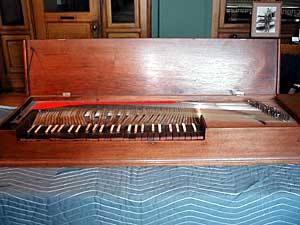|
Photos
Resources
|
April 8, 2005
 |
| This clavichord is one of only three in existence known to be American made. It is one of the instruments in the collection of the Schubert Club in St. Paul. (MPR photo/Dan Olson) |
St. Paul, Minn. — Lawrence Libin is peering into the innards of a wooden box about the size of a big tool chest. He's opened the top and uncovered a keyboard, and inside, 66 strands of wire.
Libin is the musical instrument research curator at the Metropolitan Museum of Art in New York City. He thinks he's found one of only three known American-built clavichords.
"They are not fancily decorated. It wasn't part of the tradition to paint things or to carve them fancily. So it has very simple, classical moldings around the edges, but otherwise it's just plain American black walnut around the outside," Libin says.
The story behind the instrument is murky. One version has it that a Hastings, Minnesota, antique dealer bought it from someone who found it in a Pennsylvania barn.
An Edina clavichord maker heard about it, bought it, and sold it to the Schubert Club years ago for $1,000.
The instrument appears in good shape. There aren't many nicks and scratches, and all the brass wires, two for each of the 33 keys, still run horizontally over a sound box to metal tuning posts.
Libin says clavichord owners treated the instrument like a household appliance, moving it from room to room.
"These instruments were used largely for practicing purposes, for teaching kids how to play," he says.
The clavichord Libin is examining isn't playable because he's carefully disassembling it, taking pictures and measurements -- and with each step coming closer to the conclusion that it was probably made 244 years ago by master keyboard builder David Tannenberg or his coworkers.
These days the clavichord is a musical footnote. However, in its heyday it was the instrument of choice for the masters.
Musicologists write that Bach, Mozart and other composers of the time preferred the clavichord, resorting to the larger and louder harpsichord only for public performances.
Curator Lawrence Libin says the instrument's tone is its most attractive feature.
"It's a very intimate sound, full of nuance, very sweet, not intended for concerts or big audiences -- but for personal musicmaking and practicing," he says.
The Schubert Club's clavichord joins a remarkable collection of musical instruments. It includes a Vienna, Austria-made Graf piano played for a l983 recording by Peter Serkin. Pianos quickly pushed the little clavichords out of the musical spotlight.
The Graf piano and many of the Schubert Club's instruments are playable, but president Bruce Carlson says replicas are better suited for the organization's music education and outreach program.
"You can put it in the back of a station wagon and take it to some church, have a concert. If you have an original instrument, you're a trustee of an important object from western culture and you should be pretty careful about how you use it," Carlson says.
The Schubert Club collection has thousands of items, including more than 100 keyboards, a collection of musical gongs, and metal bars or Gamelan from Indonesia, and a set of tuned fry pans used in American vaudeville.
Many are on display at its museum in downtown St. Paul's Landmark Center.
The discovery in the collection of the rare American-made clavichord strikes a welcome note among those interested in discovering and preserving this country's rich musical heritage.






